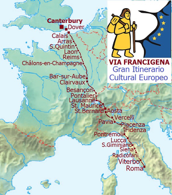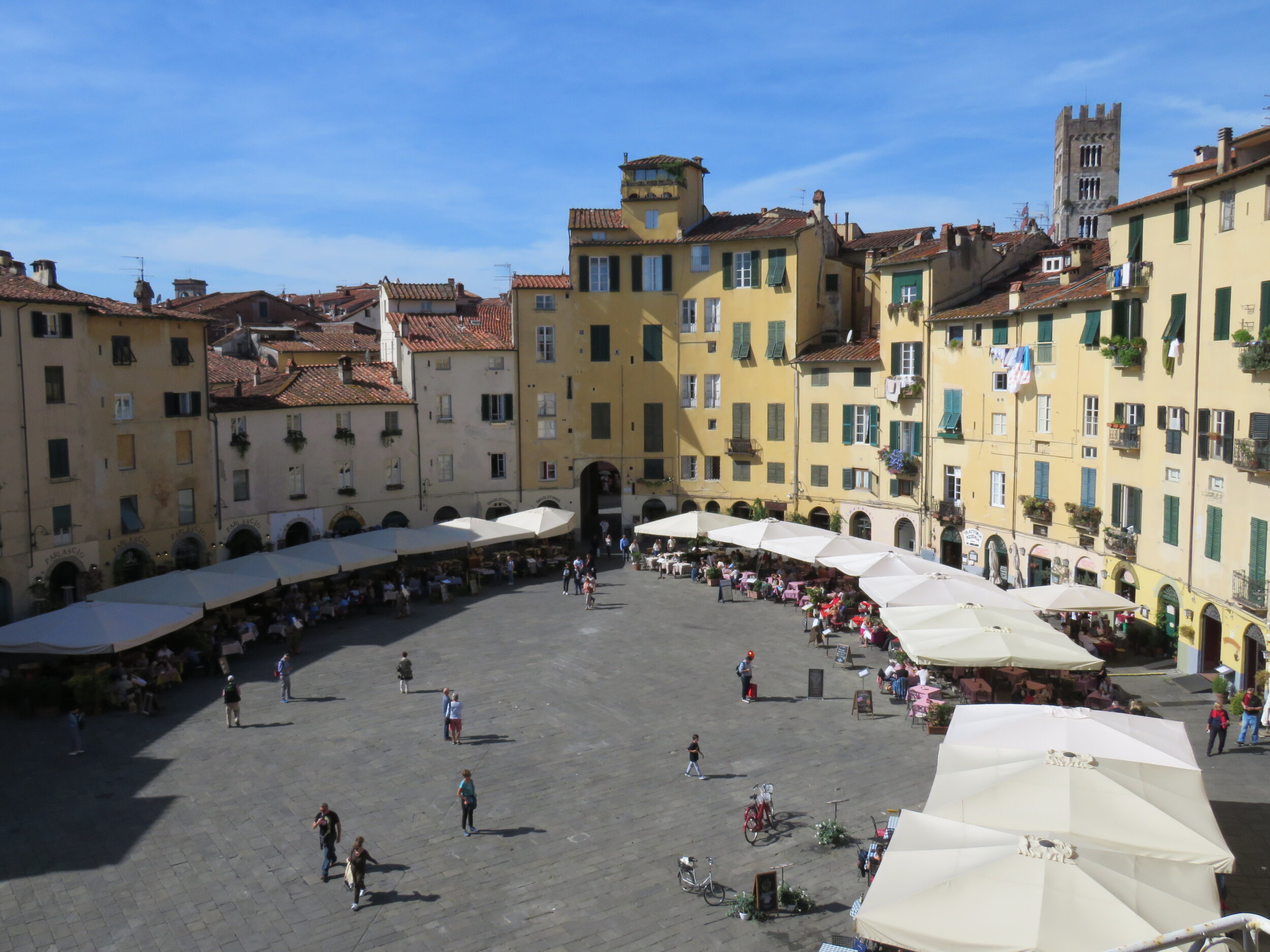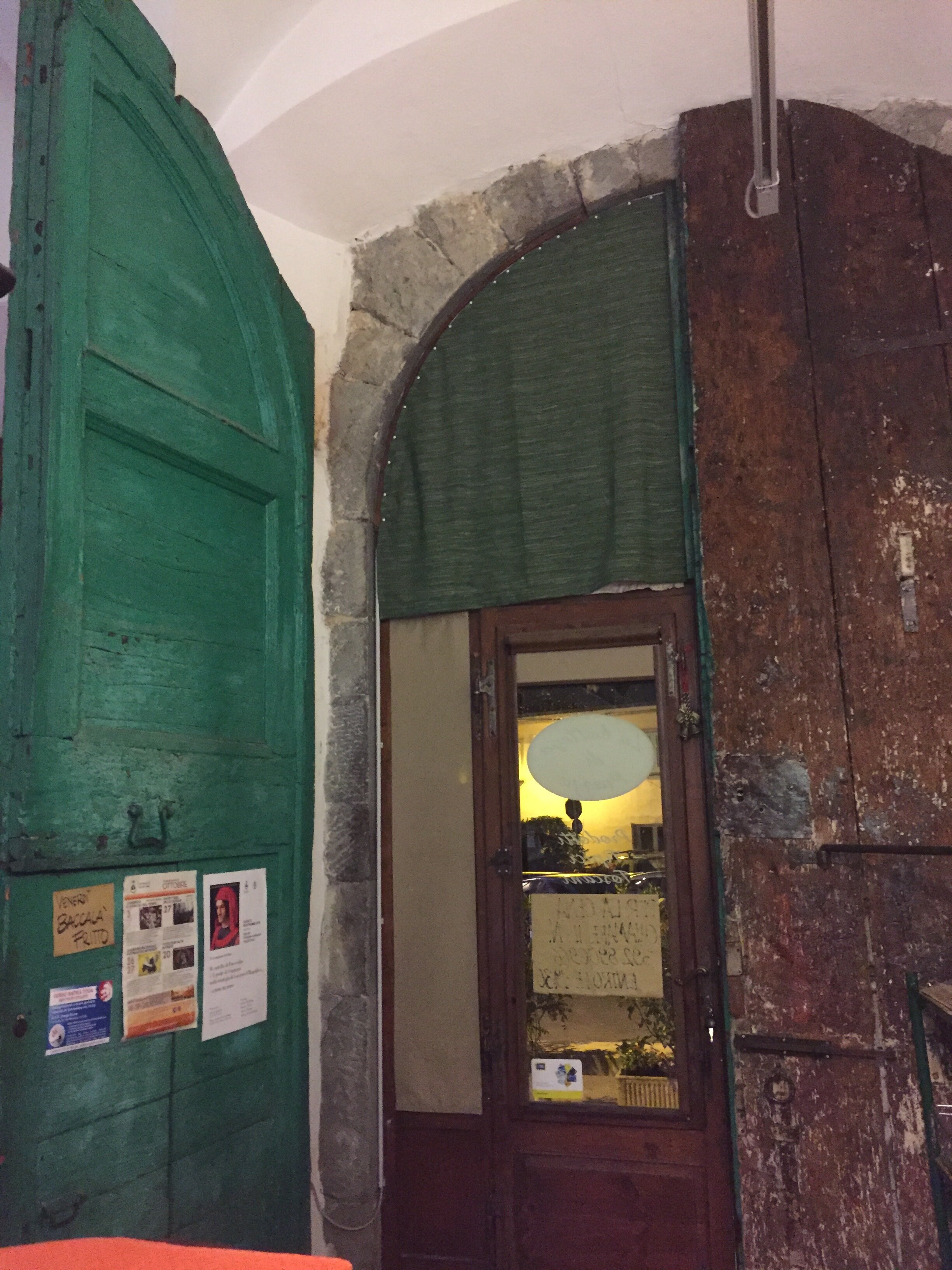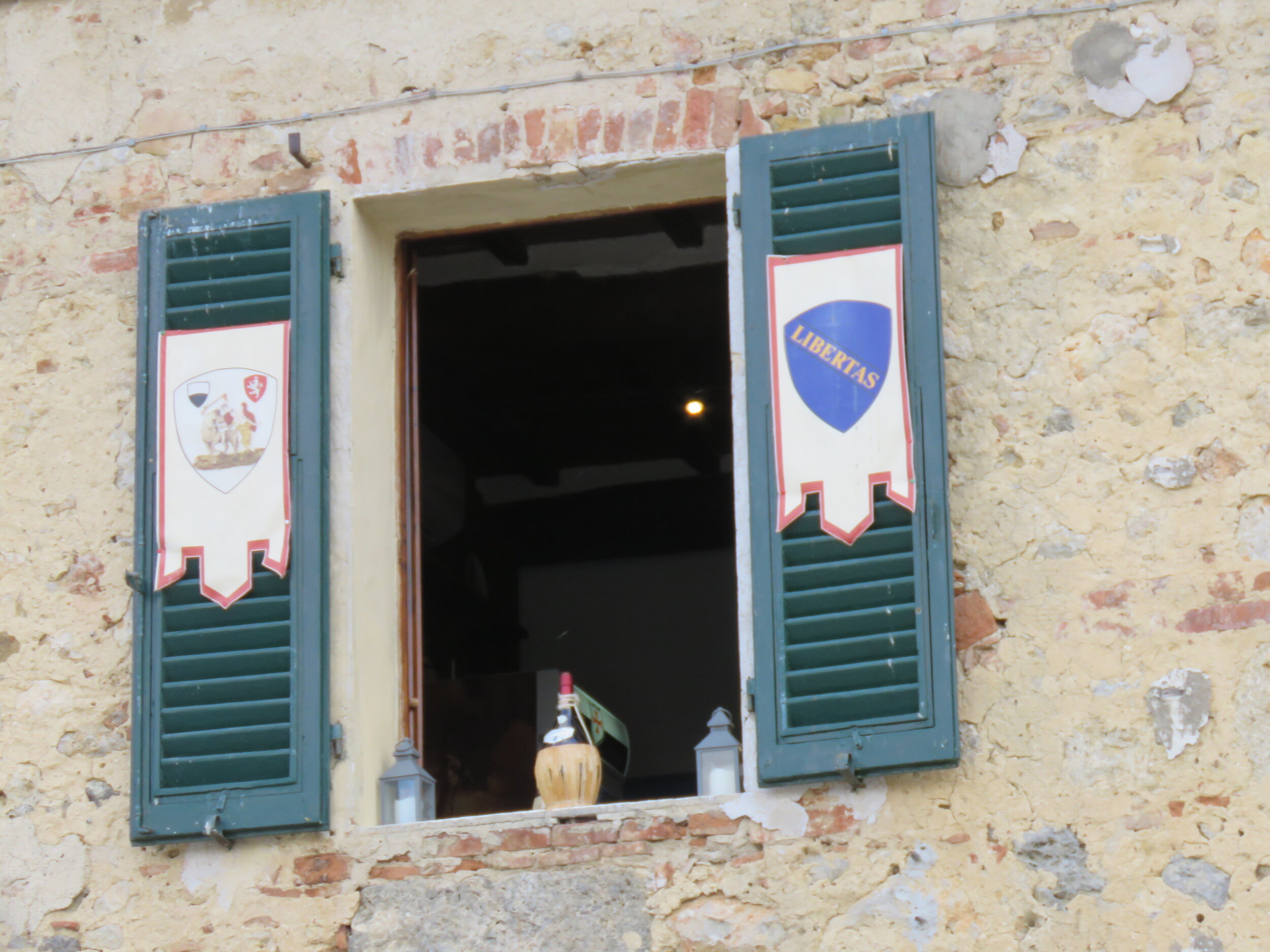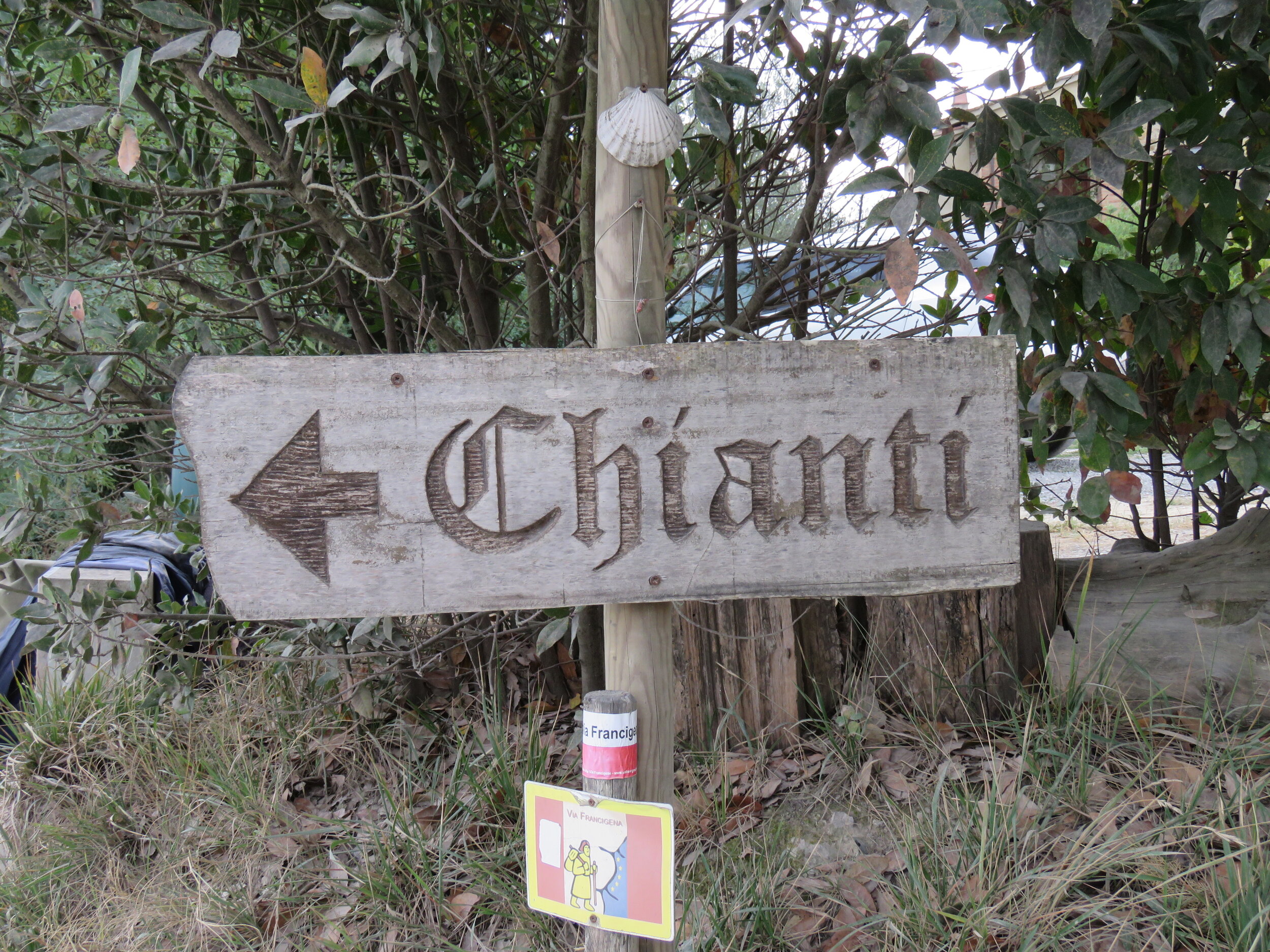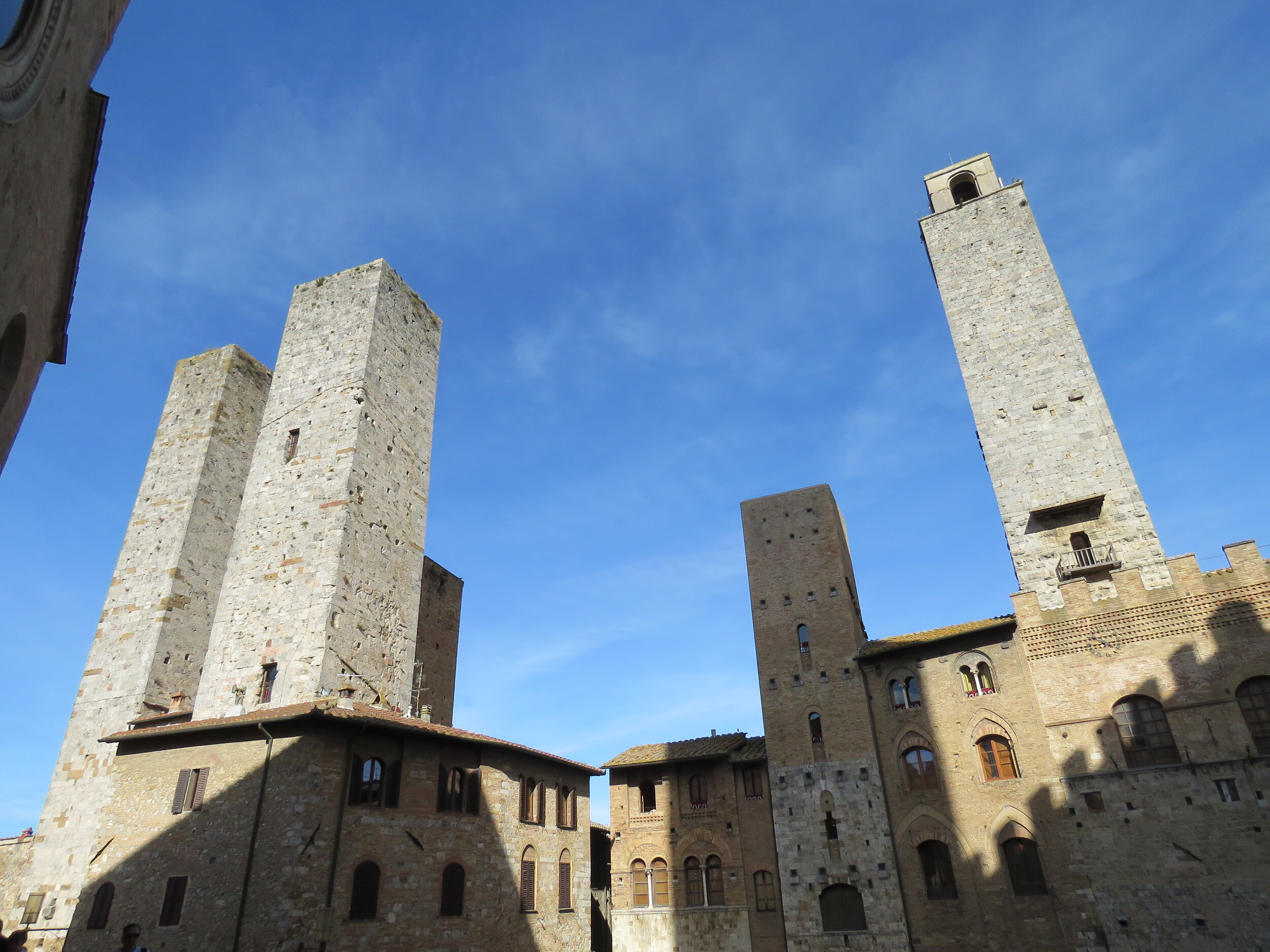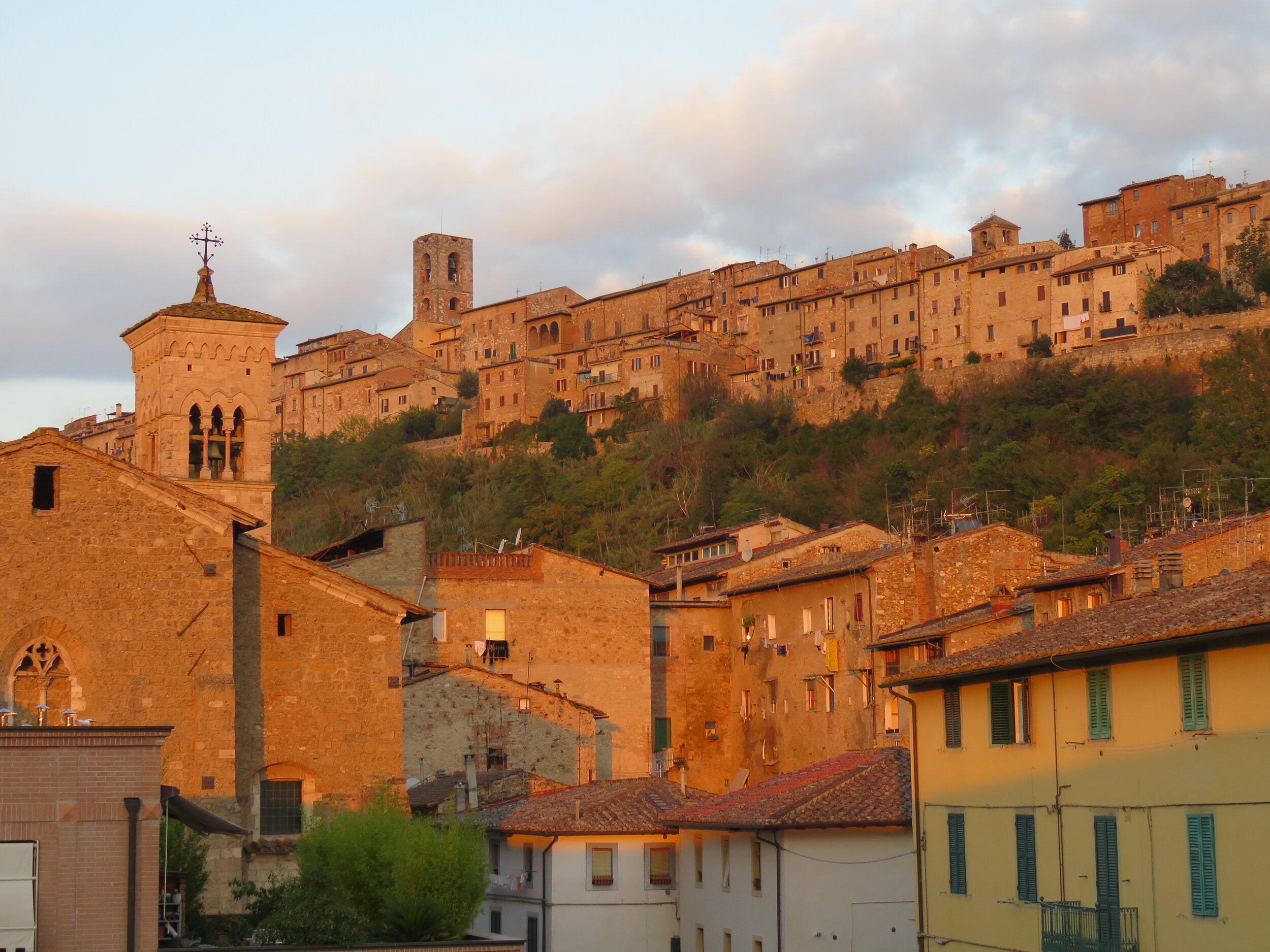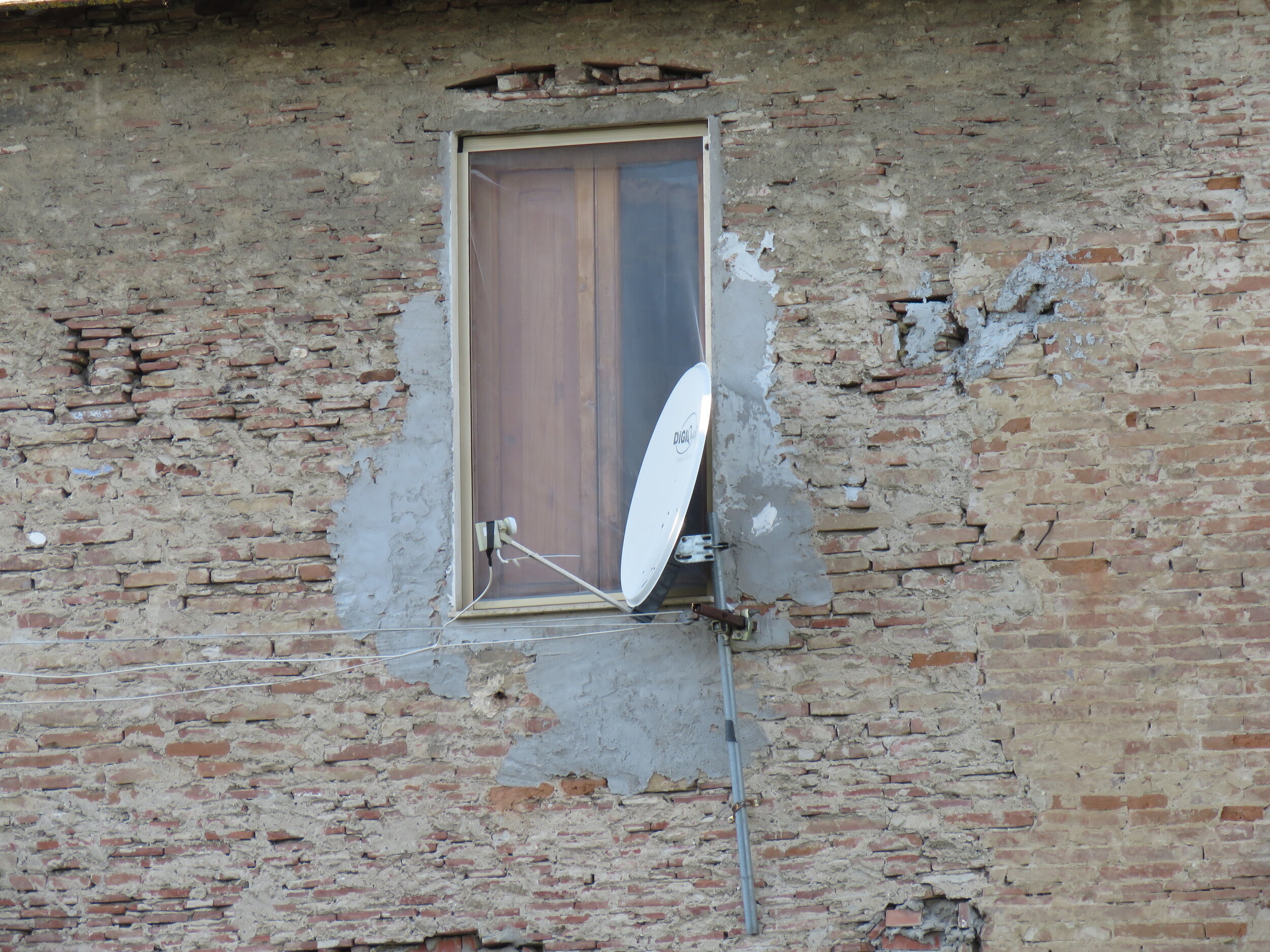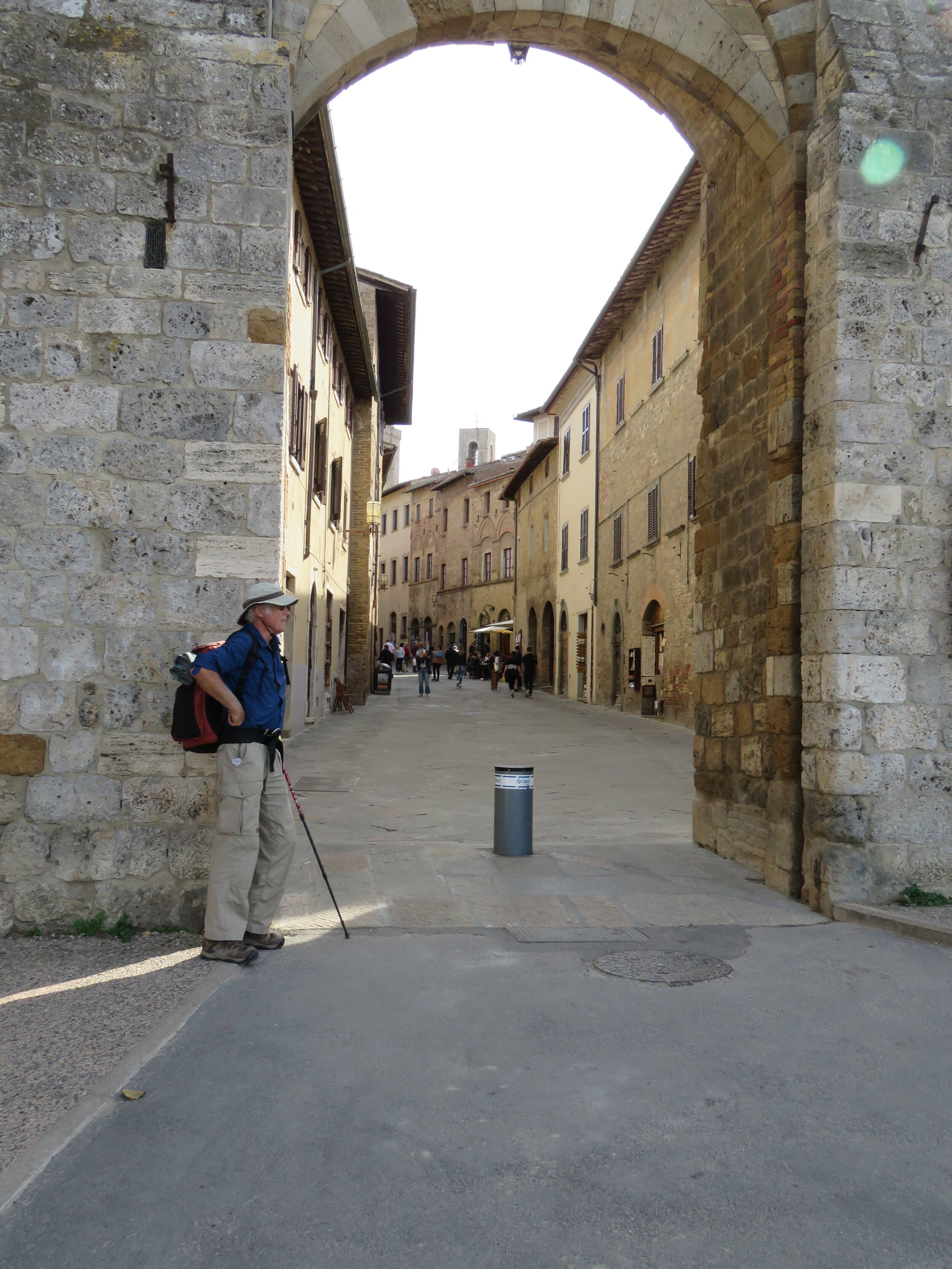We came to Italy to hike a “different camino” - the Via Francigena. Our starting point is the brandnew Museo Via Francigena in Lucca. This turns out not to be so much of a museum as it is a fantastic multimedia presentation. There are no artifacts on display but a video presentation brings the history of the trail to life between the medieval city walls of Lucca.
Since the 7th century, a passable route across Europe was important to allow for trade, invasions and more. The Italian route crossed the Apennines, followed the Magra Valley and then turned away from the coast towards Lucca. From there the path continued through the Elsa Valley to Sienna, and then the path followed the ancient Via Cassia to Rome. The original Roman paving stones were gradually replaced by a network of paths and tracks. Lodgings sprang up to accommodate travellers along the way. The name of the path was Via Francigena, or “road from France”, since it crossed modern France, the Rhine Valley and the Netherlands. It became the main connecting route between northern and southern Europe, carrying merchants, armies and pilgrims.
Two pilgrims
Pilgrimages to Rome, to Santiago de Compostela and to Jerusalem, became more and more important. Along with it, the path became a communication channel fundamental to the cultural unity of Europe in the Middle Ages. The main source of information we have today about this ancient trail, is a two page travel diary of a pilgrim named Sigeric the Serious. Seriously.
In the year 990, he traveled to Rome to be ordained Archbishop of Canterbury. His handwritten notes describe the places where he rested. The Via Francigena, flourished as a trade route: silk and spices went to northern Europe and were traded for cloth from Flanders and Brabant.
Today, the Camino de Santiago is so very popular that almost 400,000 people walk at least part of that trail each year. But many hikers, perhaps like the original Sigeric the Serious, are now looking for an alternative where they can still walk in peace and find accommodations without having to arm wrestle for a bed. Italy is turning its Via Francigena (and the entire trail is known as the Canterbury Trail) into just that. The Canterbury Trail to Rome is 2,000 KM. The Italian portion is about 1,000 KM.
The view from our room in Lucca
We decided to walk the Italian portion from Lucca to Viterbo, a 375 km stretch of the trail, taking us through much of Tuscany and a small section of Umbria. Not all the way to Rome since that would mean many kilometers in suburbs and industrial areas. We selected the most scenic parts through Tuscany (together) and Umbria (for Kees alone).
The trail markings (small red and white signs, brown traffic signs with a pilgrim, or old stones with VF painted on them) are good. Not as good as on the Camino de Santiago, but I only needed my VF app occasionally to verify that I was heading in the right direction. The best time of year for this section of the VF is April and May or September to mid October. The summers in this part of Italy are simply too hot for much hiking. The trail is mostly off pavement although there are some sections along highways that are dangerous, but by and large it is through the countryside. Lots of hills (up to 800 meter high) with absolutely outstanding views.
Traipsing through Tuscany in October sounded quite attractive. We soon realized that we would need to book accommodations along the way well ahead of time. We went in 2019 just prior to Covid hitting the world… Even when I checked a few places in March - almost half a year ahead of time - they already were full or almost full for October. But it did seem that tourism would get less in the Fall and that the weather could still be good. That turned out to be true. There are definitely others hiking the trail right now, but not in droves. And the weather has been perfect: blue skies, sunny and not too hot.
One of the hostels
Booking rooms meant that we had to figure out how far we would walk each day. We spent many hours planning the logistics. We also decided on quick dry clothing, hiking shoes and packs.
We spent two nights in Lucca and lucked out with the accommodations we had booked: a small B&B on the ancient market square in the heart of the city. Dead quiet during the night, modern and clean room and we simply walked down to the square to have our pick of small Italian eateries. We loved Lucca and want to go back some day...
Then it was time to hoist our packs on our backs and start walking. The first day was not great because it was quite urban and industrial. But we stayed in one of those big, stucco Tuscan homes. Our bedroom was large with a balcony and the bathroom boasted a huge jaccuzi. I did not enjoy carrying my 15 pound pack and, after a few days, decided to splurge on luggage transport. This made a huge difference in enjoyment. Kees still hauled his own pack while my bag vanished and magically reappeared in the next hotel. I floated up hill and downhill. OK… I still stumbled along, but enjoyed it so much better. So now I place my daily call to Bags Free, which does not mean that they transport bags for free. It refers to the fact that you walk ‘bag free’. Kees still suffers along like a proper pilgrim should.
After Altopascio we walked to a tiny town called Ponte di Capiano where we had booked 2 beds in the hostel. It turned out to be a building over a medieval bridge that housed pilgrims. We shared a room with an Italian couple. We walked over the bridge, to the tiny square in town. There the delicatessen store takes bookings for pellegrinos’ meals.
Everything was homemade and fresh. Ancient stone walls were lined with boxes of fresh fruit, mozzarella, prosciutto, bottles of local wine. In the display cases were trays of lasagne, salads and all sorts of other delicacies. For 9 euros we had our pick of main courses, including wine and dessert. They eat 3 courses here: primo, secondi platti, after you first have an appetizer and it is all followed by dessert or at least coffee and vinsanto – a dessert wine. It is beyond me how Italians can stay skinny!
We returned the next morning. The gigantic arched doors to the deli were already open. Stores here are mostly open from 6 AM til about noon, then close until 3 or 4 PM and remain open til 10 or 11 at night. We had warm croissants and coffee on a marble slab counter in the store before setting off on the day’s hike in the Tuscan hills.
One reason to keep walking…
Tuscany. It has been depicted in so many paintings and stories. What is it about this place that feels so good? Is it the exclamation marks of cypresses lining the roads? The musky smell of freshly crushed grapes as we walk by a vineyard? Surely it is not the monotonous smoked ham and bread… Oh the bread. It is just like Italian marble, solid as a rock. In the bakery, chunks of off-white bread are all thrown together in a bin. The shopping Italian ladies point and the clerk picks and holds up a chunk. “No, not that one. Thát one!” They sort and pick. It resembles a bin full of bricks. I don’t understand it because the croissants here are divine – flaky and just perfect. But the bread - you could kill someone with it if you threw a piece.
But somehow these ancient hill towns invite you to settle down and live here. I picture myself driving a tiny Fiat, like a maniac, to the patisserie each morning (for the pastries, not the bread). I love seeing the old women hang out their windows to see what’s happening on the street below, peeking through geraniums and lines full of laundry.
San Gimignano
On the Via Francigena we made it to San Gimignano – nicknamed the Manhattan of Tuscany. Only 14 of the original 72 towers remain but those make for an imposing skyline in this UNESCO World Heritage Site. As I huff and puff up hill toward the medieval centre, I wonder how they got all of those stones up there to build the towers in the 1200’s. No dump trucks back then.
Of course, no Tuscan town is complete without pizzerias and ristorantes offering wild boar and truffles. But also not without tourist traps selling fake leather purses, Pinocchio keychains and fifty flavours of gelato. After a decent meal, we walk back through the narrow medieval streets and long staircases, under a full moon.
Early the next morning, we leave town and drink in the sight. The valley below shrugs off its foggy night clothes. We walk along rows of dewy grape vines. I keep wondering if I’m traipsing through Andrea Bocelli’s vineyard yet….
We’ve been walking for hours and still have not spotted any place that might offer coffee to a wary pilgrim. I am tempted to start knocking on doors. Twice I ask but no, there’s no coffee in these hamlets. Until finally we come to a medieval huddle of homes on a hill top with a sign ‘ristorante’ pointing vaguely between the houses. The place is deserted. I’m not sure whose underwear adorns all the clothes lines hanging along the streets because no one seems to be home. Finally we find what might be a hotel and we sit down in the deserted court yard where a startled cleaning lady finds us and sends over someone who actually produces coffee. Life is good again.
Along the way we marvel at the fact that Tuscany is such a popular tourist destination but we don’t see any signs of modern, urban development. No high rises. No ugly factories. The landscape seems untouched for centuries. How did they manage that? City planners must have had incredible foresight about a hundred years ago. And that is extra impressive considering how laid back and, well, unorganized things can be in Italy. I think that Salt Spring Island can learn a lot from Tuscany when it comes to preserving the landscape.
We reach Colle di Valle d’Elsa where we have a great room, a view on the medieval city wall and a good meal outside on the square, where a posse of old men congregate on a bench at night. The local CNN.
Monteriggioni
The next medieval place is Monteriggioni. Before we went, I researched these places and studied maps. I always pictured this place as a small village, surrounded by green fields. In my mind, the town was always in a flat field. But no. Monteriggioni was built for mountain goats. A walled castle on yet another hill top. Of course, up we go. The coarse gravel makes you slip backward but we make it. Once we get inside the ancient walls, we’re in for a surprise. Whole tour groups of British and Chinese visitors follow their leaders holding a little flag. You can buy souvenirs and expensive wines. Everyone’s taking selfies with the pub or the church in the background. It’s Disneyland surrounded by ancient walls. Deflated, we buy a gelato before heading back down. We sit down at the tables of the gelato shop but get chased away. “Only sit if you get served!” the stern owner tells us. “Well, then serve me this ice cream I just bought,” Kees says but to no avail. We leave this tourist trap. Walking the quiet Via Francigena is much better.
After three days and 50 KM of walking, I have 1 blister. Not bad but not pleasant either. I do enjoy hiking but decide to cheat and take a break. While Kees happily continues along the Via Francigena, I take a bus to the next town. Gambassi Terme just happens to have a spa. Not sure if they are natural hot springs, but who cares – hot water and a sauna sound good right now. They even have a pellegrino rate.
Early in the morning I find the bus I was told to take but it is crammed with about 500 high school students, none of whom speak a word of English. The bus driver speaks even less. But I explain my destination. He nods, I climb aboard and wedge onto the by-rider seat because the entire bus is full.
Then the roller coaster ride starts. Like a true Italian, he rushes down the mountainside, screeches around curves, scattering dogs and cats and old men on scooters.
We cross a sleepy valley of vineyards in less time than it takes to say ‘Via Francigena’. When we reach the city, all students stream out of the bus but the driver gestures me to sit and stay. Then he drives the otherwise empty bus across the city to find the stop for my next bus. I’m not even sure if I’m on a city bus or a school bus. He hails down the next driver, hands me over like a baton in a relay race and looks relieved when I climb onto the next bus. I get off where my notes tell me, with my luggage, but then discover, all alone along an empty country road, that I have to climb uphill for at least 2 more kilometers until I reach the house where we’ll be staying. It’s another old fashioned Tuscan house – dark, with a fence and a big dog, chickens in the yard and shutters on the windows.
While Kees walks, meets a snake and copes with gravel paths, I drop off my luggage and lug another 1.5 kilometers uphill to my spa. I am the only customer. I slide into the lovely hot water and soak all day. Ah… being a pilgrim isn’t bad after all.
Sienna
It took us a week to walk from Lucca to Sienna. Here Margriet stayed for a week while I, Kees, continued hiking for another week to Viterbo, another 250 km closer to Rome.
There are lots of accommodation choices along the way, from a 15 euro a night hostel to 100 euro plus for a 4 star hotel. Radicofani is by far the nicest old village I came across. It has few if any tourists, no hotels, just a hostel and is the cutest little village I have seen. No new construction, narrow streets, steep as can be and very few facilities. Truly a place to be seen.
The trail varies greatly, most of the time it is on gravel roads or pathways. About 25% is on pavement and 5% of that is along busy highways where you really have to watch the oncoming traffic. Italian drivers are all on a phone and since they speak with their hands they don’t have any available for steering.
Old and new go hand in hand here.
Just outside Viterbo I hiked on the actual, original Roman road. A Roman road was 14′ wide to allow two chariots to pass each other! No more chariots flying by, but do be aware of dogs. I had to be rescued by a passing motor cyclist who positioned his big bike between me and two vicious sheep dogs. I almost had to mace the dogs, and was quite shaken. Usually my hiking poles are enough to keep smaller dogs at bay, but not the big ones.
The season seems to end by mid October, during the last 3 days of hiking on this pilgrim’s trail I saw one other hiker. Often I walk through areas totally devoid of people or buildings. It can be lonely, but that is part of the charm. Weekends are hunting days. You hear gun shots far and near throughout the day, no wonder I have seen only one very scared little deer throughout the 300+ km I walked so far.
Free water and snacks for pilgrims along the way.
Make sure you bring lunch or at least a solid snack because there are stretches where there is absolutely nothing to be had. When you go shopping in Italy you need to remember what time it is. Stores open early but, like in Spain, close again for a long siesta. By 1 PM most shops are firmly closed, to open again around 4 PM. They’ll stay open til 9, 10 even 11 PM. So you can go stock up on veggies at 10 PM but not at 1:30. You just need to get used to it. For budget conscious pilgrims, hostels are cheap: 15 to 20 euros. Twice I was all alone in the entire building because the season was basically over. However, there is also no heat in many hostels so I slept with socks on a few nights. Meals are inexpensive compared to Canada and groceries are also cheaper. Hostels often let you use a communal kitchen.
At the city gate…
I decided to stop in Viterbo because the last few day sections into Rome lead you through the outskirts and Rome’s industrial areas. All together this was an unforgettable hike through some of the most beautiful historic towns and nicest landscapes Europe has to offer.
The trail’s official site: https://www.viefrancigene.org/en/
Museum in Lucca: http://www.viafrancigenaentrypoint.eu/en
Ostello Ponte Di Capiano: https://www.viefrancigene.org/it/resource/accomodation/3967/

